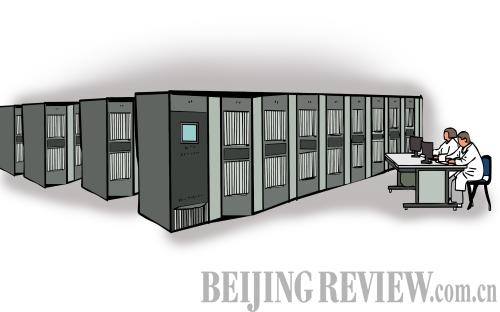|
 |
|
(LI SHIGONG) |
It's a gigantic construction site that stretches beyond the horizon. Blue and red heavy-duty trucks in endless lines trundle about beneath a gaggle of cranes hoisting steel. And all the while enormous ultramodern buildings, bearing the names of the largest local and international companies, rise from the earth.
This is Tianjin Binhai New Area (TBNA), the third major engine of China's growth miracle in terms of economic clout, after Shenzhen Special Economic Zone and Shanghai Pudong New Area. Posting a GDP figure of more than $223 billion in the first half of this year it is already growing faster than Pudong.
The figures are impressive—the area's $400 billion annual GDP is already comparable to the GDP of major nations like Argentina or South Africa. Just a 45-minute rapid rail ride from Beijing, on the east coast of Tianjin and at the center of the Bohai Sea Region, TBNA consists of nine functional zones as well as the Tianjin Port.
With a planned area of 2,270 square km, a coast line of 153 km and 2.48 million permanent residents by the end of 2010, the area has enough space, infrastructure and people to make any economic endeavor possible.
Perhaps the clearest demonstration of what this future center of the world economy is capable of achieving is the Tianhe-1 (named after the Milky Way) supercomputer, at China's National Supercomputing Center in the Binhai High-Tech Development Zone. What makes this computer so special is the fact that it runs at extraordinary speed, having been turbocharged by a team of more than 200 young engineers. It is officially the fastest computer in the world. At the end of 2010 it won a computing showdown with the U.S. Jaguar supercomputer in a top-500 international supercomputer face-off test.
The 160-ton computing beast sits in a climate-controlled room. It comprises 140 gunmetal gray machine cabinets, on which small yellow lights flicker like the eyes of mad scientists. The gentle humming that comes from the battery of machines seemed to be a symphony to the ears of our beaming guide who showed us round the hallowed halls, watching closely to ensure we didn't touch anything.
While the whole assembly looks drab and gray, as with so much in this world, it's what's on the inside that counts. Modern supercomputers are built by combining thousands of small computer servers and using software to turn them into a single entity. The large capacity of Tianhe-1A—2.57 petaflops (quadrillion calculations per second)— allows researchers to solve equations with far more variables, making measurements more accurate. The machine possesses the power of about 250,000 desktops combined and has a total memory capacity of 262 terabytes. You'd need a bionic mouse finger to keep up with that.
The guide said the center is under the dual supervision of the Ministry of National Defense and the Ministry of Education. However researchers from all over the world can make use of the machines power and its servers to ensure it hum 24 hours a day.
At present, Tianhe-1 is used, among other things, to assist with crude oil exploration, the development and production of high-end equipment, biomedical research, animation design, engineering projects, remote data processing, financial risk analysis and weather forecasting.
Experts say the machine will help workers in commercial research and development departments find ways to improve the quality of consumer products—so the machine will influence lives around the world.
Commercial firms turn to super computers as technology ensures greater profits. In the United States, Procter & Gamble even uses supercomputers to make sure that its popular Pringles chips slide into cans without breaking. A Chinese application might be strands of noodles snuggly placed in elaborately designed packets.
Interestingly our guide showed us a project where Tianhe-1 will be used to improve and prevent rail accidents, which seemed timely given the recent tragedy in Wenzhou.
On the way out we passed a giant certificate on the lobby wall proclaiming Tianhe-1's status as the top dog in international computing ranks.
And the vision and energy that went into designing a world leading supercomputer is a metaphor for the promise and success of the Binhai New Area. Propelled by a new generation of scientists and engineers China is ready to shake off its reputation for imitation and establish itself as an innovator.
With its size, infrastructure and computing power, the TBNA is ready to lead the nation's push into highest reaches of scientific and economic achievement.
The author is a South African living in Beijing | 